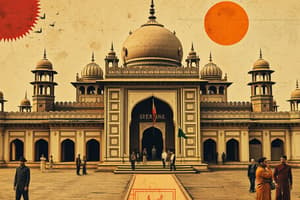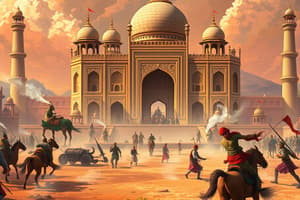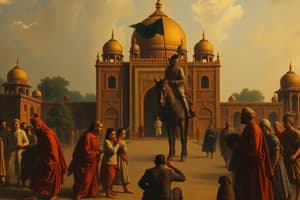Podcast
Questions and Answers
What primarily facilitated the Mughals' economic prosperity?
What primarily facilitated the Mughals' economic prosperity?
- Taxes levied on industrial production.
- Military strength and effective management policies. (correct)
- Discovery of precious minerals like gold and diamonds.
- Extensive trade agreements with European powers.
What was a key factor in the early Mughal emperors' success in consolidating their rule?
What was a key factor in the early Mughal emperors' success in consolidating their rule?
- Establishing a delicate balance between defeating and honouring opponents. (correct)
- Adopting a policy of religious persecution to ensure uniformity.
- Ignoring existing local customs and traditions.
- Forcing all defeated rulers into exile.
What was the significance of the Mughal relationship with the Rajput kingdoms?
What was the significance of the Mughal relationship with the Rajput kingdoms?
- Some Rajputs forged alliances through marriage in exchange for high positions. (correct)
- The Rajputs always remained in open rebellion against Mughal authority.
- Rajputs were completely subjugated and removed from positions of power.
- Rajput princesses marrying into the Mughal family was done without any compensation.
How did the Mughals primarily generate revenue for their empire?
How did the Mughals primarily generate revenue for their empire?
Who was responsible for collecting taxes from the peasantry during the Mughal rule?
Who was responsible for collecting taxes from the peasantry during the Mughal rule?
Who assisted Akbar in developing the concept of sulh-i kul?
Who assisted Akbar in developing the concept of sulh-i kul?
What was the original lineage of the Mughal rulers?
What was the original lineage of the Mughal rulers?
What was the Jagir system under the Mughals?
What was the Jagir system under the Mughals?
Which of the following factors contributed to the decline of the Mughal dynasty in the late 17th century?
Which of the following factors contributed to the decline of the Mughal dynasty in the late 17th century?
In which battle did Babur defeat Ibrahim Lodi, leading to the establishment of the Mughal Empire in India?
In which battle did Babur defeat Ibrahim Lodi, leading to the establishment of the Mughal Empire in India?
Which of the following factors contributed most significantly to the Mughal dynasty's success in ruling a large and diverse territory in the Indian subcontinent?
Which of the following factors contributed most significantly to the Mughal dynasty's success in ruling a large and diverse territory in the Indian subcontinent?
What was the primary source of income for the Mughal rulers during their reign in the Indian subcontinent?
What was the primary source of income for the Mughal rulers during their reign in the Indian subcontinent?
How did the Mughals' approach to succession differ from the principle of primogeniture, and what impact did this have on the stability of the empire?
How did the Mughals' approach to succession differ from the principle of primogeniture, and what impact did this have on the stability of the empire?
Why did the Mughals dislike being associated with the name 'Mongols,' despite their lineage tracing back to Genghis Khan?
Why did the Mughals dislike being associated with the name 'Mongols,' despite their lineage tracing back to Genghis Khan?
What strategies did the Mughals employ to consolidate and expand their empire after initially gaining control of territories around Agra and Delhi?
What strategies did the Mughals employ to consolidate and expand their empire after initially gaining control of territories around Agra and Delhi?
How did the Mughal practice of distributing jagirs and mansabs contribute to their expansion plans?
How did the Mughal practice of distributing jagirs and mansabs contribute to their expansion plans?
Which of the following best describes the relationships between the Mughals and other rulers of the Indian subcontinent?
Which of the following best describes the relationships between the Mughals and other rulers of the Indian subcontinent?
If a historian were examining the administrative legacy of the Mughal Empire, which of the following aspects would be most relevant to consider?
If a historian were examining the administrative legacy of the Mughal Empire, which of the following aspects would be most relevant to consider?
Flashcards
Mughal Dynasty
Mughal Dynasty
The dynasty that, unlike its predecessors, successfully built an extensive empire in the Indian Subcontinent.
Mughal Legacy
Mughal Legacy
Administrative structures and governing ideas implemented by the Mughals that persisted even after their rule ended.
Mughal Ancestry
Mughal Ancestry
Two powerful lineages from which the Mughals descended: Genghis Khan and Timur.
Primogeniture
Primogeniture
Signup and view all the flashcards
Jagirs
Jagirs
Signup and view all the flashcards
Mansab
Mansab
Signup and view all the flashcards
Tax on peasant produce
Tax on peasant produce
Signup and view all the flashcards
Akbar
Akbar
Signup and view all the flashcards
Second Battle of Panipat
Second Battle of Panipat
Signup and view all the flashcards
Rajput-Mughal Alliances
Rajput-Mughal Alliances
Signup and view all the flashcards
Rajput Resistance
Rajput Resistance
Signup and view all the flashcards
Mughal Revenue Source
Mughal Revenue Source
Signup and view all the flashcards
Decline of the Mughals
Decline of the Mughals
Signup and view all the flashcards
Babur's Victory in 1526
Babur's Victory in 1526
Signup and view all the flashcards
Zamindars
Zamindars
Signup and view all the flashcards
Subas
Subas
Signup and view all the flashcards
Sulh-i-kul
Sulh-i-kul
Signup and view all the flashcards
Study Notes
- Ruling a large and diverse territory in the Indian Subcontinent was a difficult task during the Middle Ages.
- The Mughal dynasty, unlike its predecessors, successfully built an extensive empire.
- By the 17th century, the Mughals controlled nearly all of the subcontinent, expanding from Agra to Delhi in the late 16th century.
- The Mughals implemented new administrative structures and governing ideas, which persisted even after their rule ended.
- Class 7 History Chapter 4, "The Mughal Empire," thoroughly explains these ideas.
- Extramarks offers comprehensive revision notes for Class 7 History Chapter 4, covering information from NCERT books in an easy-to-understand language
- The Mughals descended from Genghis Khan (d. 1227), the Mongol ruler of Central Asia and China, and Timur (d. 1404), the ruler of Iran, Iraq, and modern-day Turkey.
- The Mughals disliked being associated with the name "Mughals" or "Mongols" due to its association with Genghis Khan and his massacres.
- The Mughal leaders fought against rulers who refused to accept their rule.
- As the Mughal government gained power, some rulers, such as the Rajputs, voluntarily served them.
- The Mughals distributed jagirs and mansabs to support their expansion plans.
- The primary source of income for the Mughal rulers was the tax imposed on peasant produce.
- The Mughals did not believe in primogeniture, instead following common inheritance rules.
Key Mughal Rulers
- Akbar (1556-1605) became ruler at age 13 and defeated King Hemu in the Second Battle of Panipat with the help of Bairam Khan.
- Akbar also defeated many kings during the Sieges of Ranthambore and Chittorgarh.
- Akbar is considered one of the Mughal dynasty's most successful rulers.
Mughal Relations with Other Kingdoms
- The Mughals waged war against kings who refused to submit to their authority.
- As the Mughals' power grew, many kingdoms voluntarily associated with them, such as the Rajputs (arranged marriages for higher positions).
- The Rajputs of Mewar (Sisodiya Rajputs) resisted accepting Mughal rule.
- When the Mughals defeated the Sisodiya Rajputs, they were treated with respect and given land as compensation.
- The Mughal emperors increased their power by balancing humiliation and defeat.
Mughal Economy and Society
- The Mughal Empire's military strength and management policies led to commercial and economic prosperity.
- Mughal rulers and their mansabdars spent heavily on goods and salaries.
- Jagir was the distribution of income as wages to Mansabdars.
- The main source of income for the Mughal rulers was the tax imposed on peasant produce.
- Major artisanal groups, richer peasants, bankers, and merchants profited from this economic activity.
- The Mughal dynasty declined in the late 17th century, leading to the establishment of independent provinces like Awad and Hyderabad.
Mughal Legacy
- The Mughals ruled successfully until the 17th century, with changes implemented during each emperor's reign.
- The Mughals descended from Timur and Genghis Khan.
- Babur, the first Mughal emperor, defeated Ibrahim Lodi of the Delhi Sultanate at Panipat in 1526.
- Babur defeated Rana Sanga and other Rajput rulers at Khanwa in 1527.
- Babur defeated the Rajputs at Chanderi in 1528.
- Babur established control over Agra and Delhi before his death.
- Taxation on agricultural and peasant products was the primary source of income for the Mughal emperors.
- Zamindars were responsible for collecting taxes from farmers.
- All intermediaries were referred to as zamindars, some of whom were village in-charges or powerful chieftains.
- Zamindars wielded considerable power in some areas and were observed exploiting peasants.
- The Mughals ruled over several central provinces called subas, with 22 subas recorded during Aurangzeb's reign.
Key Subas
- Kabul, Kashmir, Lahore, Multan, Delhi, Agra, Awadh, Allahabad, Bihar, Bangal, Orissa, Malwa, Ajmer, Gujrat, Golkonda, Berar, Bijapur, Thatta, Khandesh, Aurangabad, Bidar, and Sira.
- Abul Fazl, Akbar's friend and counselor, helped him develop the concept of sulh-i kul to govern a diverse society.
Studying That Suits You
Use AI to generate personalized quizzes and flashcards to suit your learning preferences.
Description
Revision notes for Class 7 History Chapter 4, covering information from NCERT books. The Mughal dynasty successfully built an extensive empire, controlling nearly all of the subcontinent by the 17th century. They implemented new administrative structures and governing ideas that persisted even after their rule.




